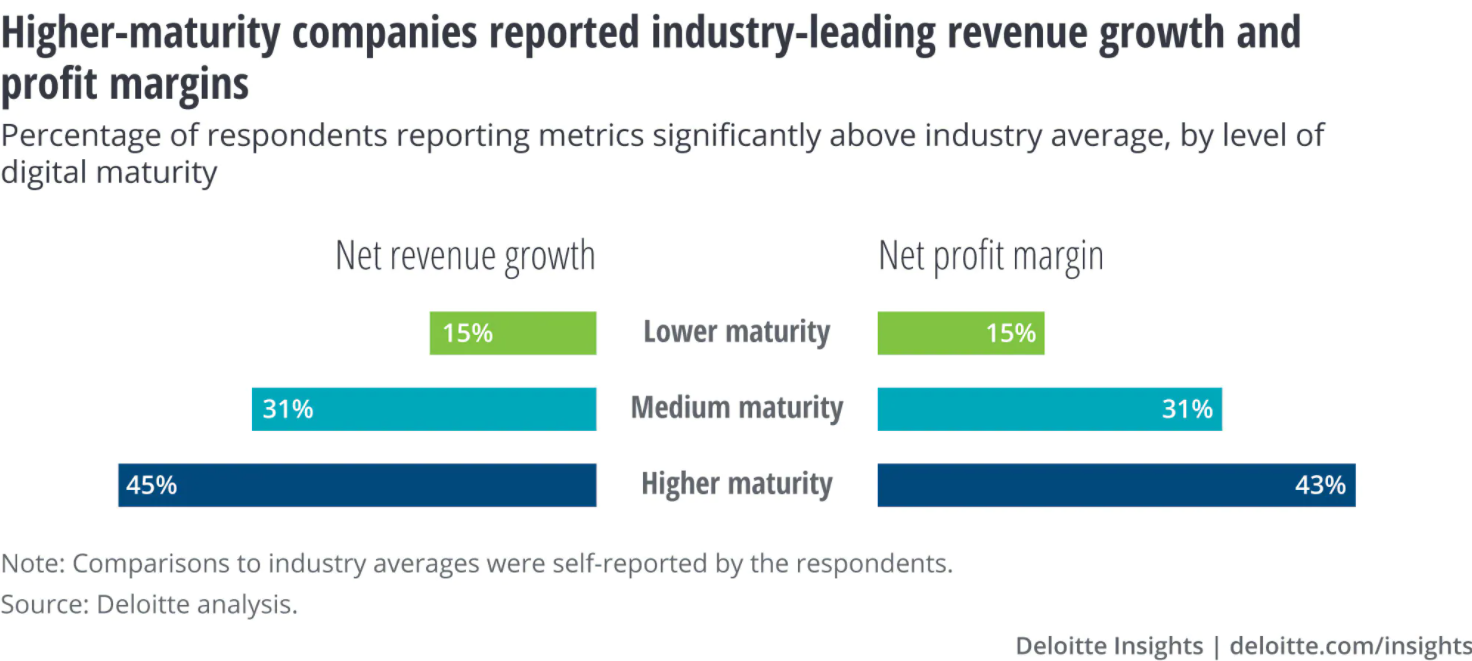When you think of a “digitally mature company,” what do you see? The term might conjure up images of tech-savvy millennials in Silicon Valley, but digitally mature companies are all around you—in every industry, in every corner of the globe. They’re enterprises that have embraced digital technology to transform the way they do business and connect with their customers.

So what does a digitally mature company look like? It’s an enterprise that:
- Has clarity of purpose and vision, and is committed to achieving it
- Invests in people, processes and technology to support its objectives
- Keeps evolving as new opportunities present themselves and new technology emerges
Digital maturity correlates with a better bottom line
However you define it, digital maturity matters—and the research shows a direct correlation between being a digitally mature company and having bottom line success.
The economic benefits of digital maturity are well documented. A McKinsey study of 2,400 companies found that those able to exploit ICT to boost efficiency grew revenue 3.2% faster annually than their peers over a five-year period. Another study looked at more than 180 publicly listed companies from around the world, finding that digitally mature organizations outperformed their less mature competitors across all financial measures. This included a return on invested capital (ROIC) 50% higher than laggards.
In an increasingly digital world, companies that embrace technology are simply becoming more competitive and profitable than those who don’t. And it’s no wonder that digitally mature companies have a competitive edge. According to the 2016 State of Digital Business Transformation study conducted by SAP, organizations that see themselves as digitally mature outperform their peers in terms of net income by 20%. In fact, those with advanced digital capabilities enjoy a 42% net income margin compared with 18% for those without any digital capability.

According to PwC’s Annual Global CEO Survey, digitally mature companies are out-performing their less digitally mature peers by 53 percent when it comes to revenue growth over the past three years.
Research shows that digitally mature companies are significantly more likely to have revenues over $1 billion than their digitally novice counterparts. And the larger the enterprise is, the greater the gap in revenue. For example, 50% of large enterprises with strong digital maturity have annual revenues over $1 billion, compared with only 10 percent of small organizations with weak digital maturity.
The numbers show an undeniable trend and help shape an answer to the question “why do digitally mature companies have better results”.
- They have resources – or they choose to invest in resources – that a) make processes easier, from operations to accounting, and b) help key stakeholders understand strengths and weaknesses, from tracking shipments to tracking customer journeys.
- Digital resources facilitate in-company communication, transparency, and speed of movement and reaction.
- Resources are freed up by these facilitated processes and communications, increasing overall productivity.
- The ROI of digitalization and digital transformation reflects in the company bottom line.
Moving toward digital maturity in every aspect of the business
A digitally mature company can be defined as a business that has invested in digital technologies to transform the way it does business to enhance customer relationships, improve employee engagement, and streamline processes.
Digital maturity is not just about having the latest gadgets or software packages. It’s a holistic approach to using technology to create value and transform your organization into one that can compete and win in today’s marketplace.
Many organizations are still struggling to make this shift. Their strategies for deploying digital technologies are often limited, and their applications are not fully functional or properly integrated. They don’t have the right tools or the right talent to execute on their plans. As a result, they’re increasingly vulnerable to disruption from start-ups, new entrants, and other competitors who are much more adept at using digital technologies to achieve competitive advantage.
Digital maturity is also essential for any organization seeking to achieve great things through innovation – whether bringing new products or services to market or delivering an enhanced experience for customers.
But digital maturity does not come easily – or quickly. If a company has reached maturity, it’s probably because the management team has been working on it for years. They’ve had plenty of time to get the details right. They’ve also built a solid customer base and cultivated positive relationships with partners along the value chain. In other words, the sooner you set off, the faster you get there.
Conclusion: Long-term digital transformation is a matter of survival
In the last decade, organizations have begun to realize that they must implement a digital approach to their business if they want to stay competitive. In the last few years, we’ve seen many companies begin to make this shift.
What does it take for an organization to become digitally mature? There are four components:
1) Business strategy. Companies that put together a digital strategy from the top down with support from the board are more likely to move forward than those that don’t create one.
2) Technology strategy. A technology strategy is essential for development, but it must be in line with an organization’s overall business goals.
3) Governance. Establishing governance structures can help organizations focus on what’s most important during times of uncertainty.
4) Employee skills. Organizations need a skilled workforce to be successful digitally, but training and development aren’t enough—digital maturity programs must be incorporated into daily operations.
Truly digitally mature organizations—that is, those that are able to reap the benefits of digital transformation—are already seeing demonstrable results. They’re seeing a return on their investment of time, money and resources; they’re becoming more efficient and effective; and they’re capturing new revenue streams.















